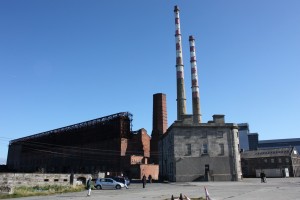
On Saturday October 6th I went on a tour of the Pigeon House precinct as part of Open House Dublin 2012. The tour was guided by Charles Duggan and Grainne Shaffrey and was held to raise awareness of the old power station complex. The complex was under the management of the ESB for most of the 20th century but the last 6 years it has been under the ownership of the Dublin City Council.
Dublin Bay has a long history of use as a berthing place, going back as far as 1707. It was very treacherous, full of sand banks, mud flats, silt and channels but there were a number of deep pools were boats could berth temporarily and off load passengers. They would come across to what was known as the Ringsend Spit which was at the mouth of the Dodder, then by road across to the city centre by horse and carriage. This was effectively the start of the Dublin Port and Docks.
One of the major projects it initiated in the early part of the 18th century was the Great South Wall. They used a series of timber piles which formed the Eastern end of the Great South Wall out to approximately where the lighthouse is today. Later the timber piles were replaced by concrete which are there today. This is beautifully made and if you look carefully you can see that there is a lot of bends in the wall to follow where they could get firm spots.
In 1888 we had the first development of electricity and the first electric lights in the streets shortly after that. At the end of the 19th century electricity became more readily available. This led to a whole load of micro companies setting up their own energy companies, a bit like now with renewable energy where everybody is trying to get on the band wagon. Unfortunately, this led to a very irregular service and Dublin Corporation set up its own energy making company out of Fleet Street. They realized they needed to take this onto a bigger scale so after a lot of debate, the decision was made to set up Dublinís first sizeable power station at Poolbeg. At the same time the city was developing a municipal sewage treatment works and wanted to develop them both out there. At the time the lands were in the control of the military.
In February 1902 the first phase of the power station took place when the first foundation stone was laid. Then in 1911 power was in such great demand that the power station was extended quite significantly and one of the interesting aspects of what was known as the Dublin Electricity Generating Station was that it was so far out from customers it was required to use three phase electricity. This was quite controversial at the time and a bit of a risk and certaintly it was the first use of three phase electicity in the British Isles and maybe the first use in an urban context worldwide as well.
In 1927 the ESB was established and with the beginning of the Irish State a lot of positive independent Irish companies looked forward to the future. In 1928 Ardnacrusha Power Plant was developed on the Shannon and the thinking was that hydroelectric power was the way forward. Poolbeg was downscaled and power production was halved temporarily. In the 1930’s we had two years of draught on the Shannon which caused another phase of investment in the development of the Poolbeg Power Station. This is more or less what we see today. The iconic red and white chimneys, one of the most recognized landmarks in modern Ireland puffed their last plume of smoke in 2010 and due to lack of use will disintegrate naturally. The power station, pigeon house hotel, harbour and fort are currently being explored for military, industrial and maritime heritage in a conservation plan orchestrated by Dublin City Council.
By Jason McDonnell



